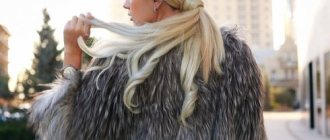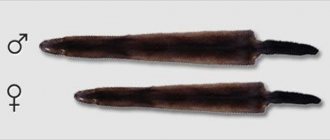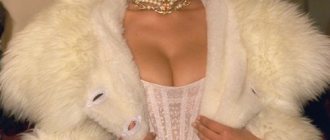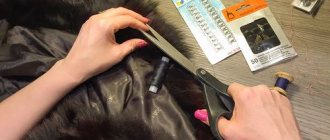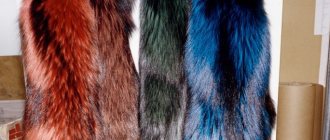- Fur coats
- Fur vests
- Collars and cuffs
- Hats and accessories
An expensive fur item is not immune to various contaminants, and cleaning it yourself is dangerous - there is a possibility of ruining a beautiful item and deteriorating its quality. Specialized fur dry cleaning “ChristieS” offers a cleaning service for fur coats, hats or vests, ensuring the preservation of the beauty of the products.
Prices
Fur coats
| Name | Price |
| Fur coat (faux fur) up to 90 cm | 2400 rub. |
| Fur coat (faux fur) from 90 cm | 2800 rub. |
| Fur coat (fur of the 3rd category) up to 90 cm | 7500 rub. |
| Fur coat (fur of the 3rd category) from 90cm | 8500 rub. |
| Fur coat (2nd category fur) up to 90 cm | 4850 RUR |
| Fur coat (2nd category fur) from 90 cm | 5450 rub. |
| Fur coat (fur of the 1st category) up to 90 cm | 3650 rub. |
| Fur coat (fur of the 1st category) from 90 cm | 4250 rub. |
Fur vests
| Name | Price |
| Faux fur vest from 90cm | 2000 rub |
| Faux fur vest up to 90cm | 2000 rub |
| Vest (3rd category fur) up to 90cm | 4000 rub |
| Vest (3rd category fur) from 90cm | 4000 rub |
| Vest (2nd category fur) up to 90cm | 3500 rub. |
| Vest (2nd category fur) from 90cm | 3500 rub. |
| Vest (fur 1st category) up to 90cm | 2500 rub. |
| Vest (fur 1st category) from 90cm | 2500 rub. |
| Faux fur lining | 1250 rub. |
Fur collars and cuffs
| Name | Price |
| Collar, cuffs (3rd category fur) | 1000 rub |
| Collar, cuffs (2nd category fur) | 1000 rub |
| Collar, cuffs (1st category fur) | 1220 rub. |
| Collar, cuffs (faux fur) | 800 rub |
Hats, mittens and other fur accessories
| Name | Price |
| Mittens, gloves | 1500 rub. |
| Belt | 1000 rub |
| Faux fur hat | 1000 rub |
| Category 3 fur hat | 4000 rub |
| Category 2 fur hat | 2420 rub. |
| Category 1 fur hat | 1820 rub. |
Additional services
| Name | Price |
| Packing things in a case (short) | 360 rub. |
| Packing things in a case (long) | 410 rub. |
Fur of the 3rd category - sable, marten, ermine, fisher, lynx, chinchilla, broadtail
Fur of the 2nd category - raccoon, fox, scribe, mink, astrakhan fur
Fur of the 1st category - dog, wolf, nutria, sheepskin, llama, rabbit, muskrat
* Finished with fur of a higher category, the presence of a large hood-collar (shawl) - 10% of the cost of cleaning the product.
* Manual cleaning - 50% of the cost of cleaning the product.
Fur coats, hats, vests, collars - in winter they give you an irresistible look, give you warmth and comfort. Unfortunately, the appearance of fur products can be spoiled for many reasons. Wet snow or rain, dust, strong odors, reagents, cosmetics and other pollutants leave marks on them, the fur becomes dull, wrinkled, and the fibers stick together. And the fur coat is no longer so pleasing to its owner, although it was not cheap. But there is a way out - contact a dry cleaner specializing in fur cleaning.
Where can I dry clean my fur coat?
Dry cleaning is an establishment that specializes in fur cleaning. In addition to the fact that the specialists of this establishment will not only help you clean the fur of your fur coat, they will also bring it back in order: they will repair the product and paint it (if necessary). Here you can leave your fur coat for storage.
A professional dry cleaner should have an ironing machine at their disposal to smooth out the fur. But since this equipment is quite expensive, every establishment can afford to purchase it. In principle, the presence of an ironing machine indicates that the establishment receives a lot of orders and values its reputation, because the product must be returned to you not only in its pure form. It must be wearable and look well-groomed.
In big cities, in addition to dry cleaners, there are ateliers and fur salons that sew fur clothes. They can also offer you dry cleaning services for the product.
Specialized fur dry cleaning in Moscow
Fur care services in Moscow are offered by the ChristiS dry cleaning chain. Our experience and professional equipment allows you to be confident in an excellent result. Fur items after our salon look like new and will serve for many years.
When using fur products, regular care is very important - this is the main condition for the durability of the product. Even if at first glance everything is in order, do not forget to clean, polish and restore your fur items once a year. Moreover, the cost of fur dry cleaning is quite affordable for everyone. We are waiting for you in ChristiC salons!
You can also order field service using the phone number indicated on the website.
Methods for cleaning fur products
There are two main methods for cleaning fur:
- Rolling in sawdust or special cleaning granules.
- Use of organic (natural, natural) solvent. This is perchlorethylene or hydrocarbon.
The latter is used for delicate cleaning. It is not suitable for cleaning heavily soiled fur or lining of the product. After cleaning with hydrocarbon, the pile remains a little greasy. It is highly not recommended to iron the product in this condition.
Perchlorethylene, on the other hand, is used to clean tough stains. After treating the fur with this product, it will be restored soft and silky. It can be ironed.
Is it possible to clean a fur coat at home?
Cleaning a fur coat at home using folk remedies is not advisable, because at best, you will not get results, and at worst, you will ruin your fur coat. It is better to put all recipes using vinegar, gasoline, starch, peroxide and other means aside and take your natural fur product to a dry cleaner, where professionals will take care of it.
How to clean a fur coat after the season?
Winter is a real test of durability for your fur clothing. Its notorious enemy is not so much dirt and slush, but the salt that is used to sprinkle sidewalks.
Regular contact with salt can turn your fur coat into a mangy cat after a few seasons.
To restore such a product to its former beauty, a fat emulsion is applied to the affected area. But this remedy does not help in all cases. If the hem of the fur coat is long, then to restore it you will need to carry out aqua-cleaning. But this method has one big disadvantage: your fur coat will decrease by half a size, and in some cases, by a size.
What contaminants are impossible to get rid of?
It is impossible to clean fur from stains from vegetable and machine oil, some drinks, wine, and food. For example, vodka has no effect on the fur, while it leaves stains on the lining, and it is very difficult to clean the lining material.
It is also quite difficult to remove traces of powder and foundation from the collar fur. The reason for this lies in the fact that the fatty base and pigment actively interact.
How often can you dry clean your fur coat?
Fur can be dry-cleaned up to six times.
What to consider when choosing a fur coat. What problems can arise with dry cleaning?
All problems can be divided into three groups:
- problems that may be associated with the type of fur. Thus, astrakhan fur coats are considered problematic because they can shrink after cleaning. Arctic fox coats have too thin leather fabric. Light furs quickly turn yellow, although this problem can be solved with dry cleaning.
- problems that may be associated with the design of the fur coat. As a rule, expensive furs are difficult to clean. These include: sable, mink, fur coats combined with suede (this material does not tolerate fur cleaning products well). In this case, the suede inserts have to be replaced with new ones.
- The third group of problems includes improper sewing or dressing of hides. If the quality of the fur paint is low, then during dry cleaning such paint will become discolored and the result will be a faded fur coat. If the skin is too stretched, then after processing the fur coat will shrink. The same rule applies to low-quality fittings.
[Total: 7 Average: 3.1/5]
Dry cleaning of fur coats in questions and answers
To bookmarks
Dry cleaning technologist Andrei Artamonov answers our questions.
Fashion and Fur Magazine (hereinafter referred to as MiM): What methods of dry cleaning of fur products exist?
Andrey Artamonov (hereinafter referred to as AA): At the moment there are five cleaning methods:
- Cleaning with an organic solvent (perchlorethylene or hydrocarbon),
- hydrocarbon KWL,
- halogen-free solvent solvon K4,
- rolling in special cleaning granules or sawdust,
- bio-cleaning of fur coats (a new method without GOST yet) using Salad technology, developer Dmitry Degtyarev
The expensive hydrocarbon solvent allows you to delicately clean a fur coat, but is almost useless if the fur and, especially, the lining are heavily soiled. Therefore, it is very common in the West and is almost never used here (now there are no more than 10 machines of this type in all of Russia). Russian dry cleaners use perchlorethylene. It perfectly removes dirt, and also allows you to use an ironing machine after cleaning, with which special compounds are applied to the hair, giving the fur silkiness and shine. After cleaning with hydrocarbon, such an operation is strictly prohibited due to residual oiliness of the hair. Previously, the solvent used was freon, which is no longer used for environmental and economic reasons.
Surface cleaning in special retractable drums is currently not used at dry cleaning enterprises for several reasons: economic infeasibility, lack of equipment and qualified personnel.
By the way, in the USSR, every regional center was equipped with retractable drums, ironing machines and longboats for dyeing fur and leather. And now, for example, in Moscow only five dry cleaners are equipped with ironing machines, and retractable drums remain only in fur production.
"Folk remedies:
- Starch,
- petrol,
- vinegar,
- alcohol
- and so on.
And modern preparations for manual cleaning ( biofur ) do not allow you to effectively clean fur at home.
IT'S JUST SO BEAUTIFUL IN ADVERTISING, YOU CAN'T COMPARE WITH OLD AND RELIABLE PRE-CHLOR!
Little tricks from A. Andrey:
Clean your fur item in the spring. In this case, dry cleaning “kills two birds with one stone”:
- Removes dirt
- and carries out prevention against moths and carpet beetles (in the spring-summer period, the larvae of these insect pests become active).
MiM: How many dry cleaners can a fur coat withstand?
AA: With the correct dry cleaning regimes:
- Low temperatures perchlorethylene,
- washing time,
- adding fat to the sink,
- drying.
A fur product can be cleaned up to seven times.
MiM: From your experience, what stains are most typical for a fur product?
AA: Most often, situations occur when a person pours something on himself. What’s most interesting is that the first place on this list is…. You'll never guess it - vegetable oil! Next come drinks, food products, and motor oils. Moreover, even liquids that are harmless to fur, for example, vodka, leave difficult-to-remove stains on the lining.
In general, cleaning linings, especially natural ones (silk, cotton), causes a lot of problems. By the way, it is impossible to remove perfume stains from the lining.
A serious problem is the marks on the collar from cream powder, which is a mixture of fats and pigment. This pigment is fixed on the fur, especially on light fur, and it is no longer possible to remove the consequences. And, of course, the “scourge” of Russian winter roads is calcium chloride.
MiM: Is it possible to “save” a fur coat that has gotten wet in “anti-ice”?
AA: It’s easier to work with the situation of getting wet in this salt once. The most difficult thing is when a long product has been repeatedly exposed to aggressive influences over the course of a season, or even several. There were cases when the hem of a fur coat literally curled into a tube. You can apply a fat emulsion to the affected area and leave it for a while. This helps in about 50% of cases. Salt can be easily removed from long sheepskin coats using aqua-cleaning, but a fur coat cleaned using this technology will shrink by about half a size. The decision depends on each specific case and, most likely, you will have to sacrifice something.
MiM: What potential problems with dry cleaning fur coats can be predicted even at the level of purchasing the product?
AA: We can divide them into several groups:
- The first is problems caused by the type of fur. For example, products made from arctic fox and nutria are characterized by very low tensile strength of leather fabric. Products made from astrakhan fur and astrakhan fur shrink a lot. White furs turn yellow, and although there are chemicals that restore whiteness, they are intended primarily for fur dressing and are rarely found in the dry cleaning arsenal.
- The second is problems caused by product design. It is very difficult to clean sheepskin coats made from expensive furs - mink, sable. Combined products with artificial suede can only be cleaned in hydrocarbon; in perchlorethylene, artificial suede is greatly deformed, and its parts require replacement.
- The third group is problems of quality of dressing and tailoring.
A product painted with low-quality dye may become discolored. Overstretched skins “shrink.” But the main problem is the cheap fittings: loose clips come unfastened during dry cleaning, the open hook gets into the drum cell and comes out “with meat” when moving. The lock on the fur coat was torn out
MiM: What pitfalls exist in dry cleaning fur products?
AA: The main problem of dry cleaning enterprises is, no matter how trivial it may sound, the human factor. For example, in Moscow there are about five dry cleaners that are “technically” capable of cleaning fur products perfectly. But the lack of the required number of qualified personnel does not allow consistently obtaining high-quality results. It gets to the point that fur coats cleaned in the same dry cleaner, but on different shifts, can differ like “heaven and earth.”
MiM: If “everything is so neglected,” maybe it’s better to clean your fur coats abroad?
AA: In Italy there is a chain of dry cleaners, owned by Antonio Lasala, who specializes exclusively in fur, and things are brought to him from all over Italy. However, if we talk about the “average” foreign dry cleaner, then this makes no sense. In addition, it should be understood that European fur coats do not have such a strict operating regime and the culture of wearing fur there is completely different than in Russia. From my experience, every fourth fur coat brought to the dry cleaner also requires repair.
Little tricks from Andrey Artamonov:
Once a week, carefully, trying not to scratch the leather tissue, comb the fur coat with a soft pin brush for cats, which can be purchased at any pet store. This is an excellent preventative against pollution.
MiM: How then to choose a dry cleaner for fur?
AA: A dry cleaning company positioned as a “specialized fur shop” must provide three services: the actual cleaning, repair of fur products and their storage.
Another sign of a specialized dry cleaner is the presence of a fur ironing machine. The presence of such expensive equipment indicates that the company cleans a large number of fur products and attaches great importance to the aesthetic appearance of the result of the work. So “innocent” questions about repairs and ironing machines can sharply narrow your search.
High-level fur cleaning services are provided by some Russian factories that specialize in sewing fur products. For them, repairs and cleaning are related services that are not significantly related to cost. Therefore, most often, the most expensive chemicals are used there and good fur specialists work there. But, naturally, first of all, these factories serve products of their own brand.
(Visited 453 times, 18 visits today)
0
Author of the publication
offline 2 hours
Timur Lapanov
5,8
Perchlor is more a friend than an enemy



